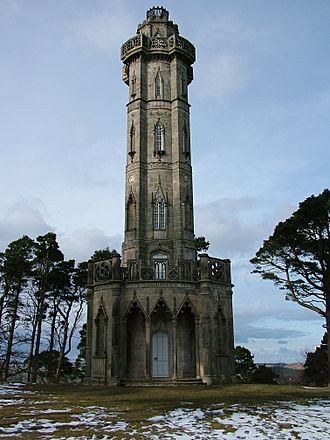Brizlee Tower facts for kids
Quick facts for kids Brizlee Tower |
|
|---|---|

Brizlee Tower in 2006, before its renovation
|
|
| General information | |
| Status | Grade 1 listed |
| Type | Folly tower |
| Architectural style | Gothic Revival |
| Location | Hulne Park, Alnwick, Northumberland, England |
| Coordinates | 55°25′35″N 1°45′07″W / 55.42636°N 1.75186°W |
| Completed | 1781 |
| Client | Hugh Percy, 1st Duke of Northumberland |
| Height | 26 metres (85 ft) |
| Technical details | |
| Floor count | 6 |
| Design and construction | |
| Architect | Robert Adam or John Adam |
| Designations | Grade 1 listed |
Brizlee Tower (sometimes called Brislee Tower) is a special kind of building called a Grade 1 listed folly. A folly is a building built mainly for decoration, not for a practical purpose. This tower sits on top of a hill inside Hulne Park. This park is a large, walled area that belongs to the Duke of Northumberland in Alnwick, Northumberland, England. The tower was finished in 1781 for Hugh Percy, 1st Duke of Northumberland. It offers amazing views of North Northumberland and the Borders region.
Contents
Discovering Brizlee Tower
Brizlee Tower is 26 metres (about 85 feet) tall. It is a very fancy tower made of dressed stone. It stands on the edge of Brizlee Hill, which is about 177 metres (580 feet) above sea level. This high spot gives the tower incredible views in many directions.
What You Can See from the Tower
From Brizlee Tower, you can see far and wide. You can spot:
- The valley where the River Aln flows.
- Old and new country homes like those at Eslington and Bolton.
- Hulne Priory, an old monastery, inside the park.
- Distant hills like The Cheviot and the Teviotdale hills.
- The coastline with islands like the Farne Islands and Coquet Island.
- Famous castles such as Bamburgh, Dunstanburgh, and Warkworth.
However, views to the south are blocked by Alnwick Moor, which is even higher.
Why Was the Tower Built?
The tower was ordered around 1777. It was built to remember Lady Elizabeth Seymour. She was the wife of Hugh Percy, 1st Duke of Northumberland, and she passed away in 1776. The tower was completed around 1781. Its main job was to be a viewing platform for the Duke's park. This park was designed by the famous landscape architect "Capability" Brown.
The Tower's Design and Features
Brizlee Tower has six levels. The lowest level has a verandah (an open porch). The very top level has a viewing platform or balcony. On top of this platform is a cast-iron fire basket. Before the tower was built, Brizlee Hill was said to be a place where fire-beacons were lit. These beacons would warn people if enemies were coming.
The tower is round. It also has four small, rectangular buttresses that stick out slightly. Inside, there's a spiral staircase that goes up through the middle. Windows light up the staircase.
Who Designed It?
The tower is built in a style called Gothic Revival. This style brings back ideas from medieval Gothic buildings. People aren't completely sure who designed it. Some say it was Robert Adam or his brother John. These architects also worked on other buildings for the Duke. Some even say the Duke himself or his French pastrycook might have helped design it!
One expert, J. Mordaunt Crook, described the tower as very creative and wild in its design. He said it mixes different styles, like classical decorations with Gothic spires. He called it "Rococo fantasy."
A Special Message on the Tower
Above the balcony, you can see the Duke's family crest. Below it, there's an inscription in Latin. It says: Circumspice! Ego omnia ista sum dimensus; Mei sunt ordines, Mea descriptio Multae Etiam istarum arborum Mea manu sunt satae. This translates to: "Look around! I have measured out all these things; they are my orders, it is my planning; many of these trees have even been planted by my hand." This shows how proud the Duke was of his park and the tower.
Saving Brizlee Tower
Brizlee Tower was given a Grade 1 listing in December 1969. This means it's a very important historical building. However, by the end of the 1900s, the tower was in trouble. It had a lot of water damage and its iron parts were rusting. Because of this, it was put on the Buildings at Risk Register and closed to visitors.
Luckily, the tower was fully repaired in the early 2000s. Even though it's still not usually open to the public, sometimes people can visit for special charity events.


